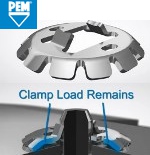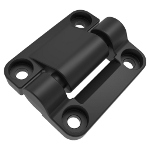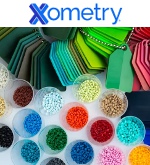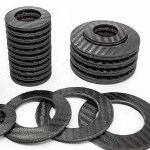 |
| January 09, 2024 | Volume 20 Issue 01 |
Mechanical News & Products
Designfax weekly eMagazine
Archives
Partners
Manufacturing Center
Product Spotlight
Modern Applications News
Metalworking Ideas For
Today's Job Shops
Tooling and Production
Strategies for large
metalworking plants
New 'breathable' rupture disk tech provides overpressure and vacuum relief
 To increase equipment safety and reliability, a new rupture disk technology activates at a set burst pressure, but it can also "breathe" to relieve minor pressure fluctuations. The patent-pending, dual-function device from BS&B Safety Systems is ideal for use on low-pressure vessels that are susceptible to ambient temperature changes.
To increase equipment safety and reliability, a new rupture disk technology activates at a set burst pressure, but it can also "breathe" to relieve minor pressure fluctuations. The patent-pending, dual-function device from BS&B Safety Systems is ideal for use on low-pressure vessels that are susceptible to ambient temperature changes.
Read the full article.
Engineer's Toolbox: 9 considerations for specifying a slewing ring bearing
 In applications that require a bearing to support a structure while it rotates (e.g., cranes, radar, tank turrets), premature bearing failure can put people and equipment at risk. While slewing ring bearings have proven themselves countless times in such applications, designers must consider many factors when specifying them. According to engineers at Kaydon, the bearing's support structure, mounting (including bolt strength, tensioning, and hole patterns), installation, and even storage are all factors in a bearing's success or failure.
In applications that require a bearing to support a structure while it rotates (e.g., cranes, radar, tank turrets), premature bearing failure can put people and equipment at risk. While slewing ring bearings have proven themselves countless times in such applications, designers must consider many factors when specifying them. According to engineers at Kaydon, the bearing's support structure, mounting (including bolt strength, tensioning, and hole patterns), installation, and even storage are all factors in a bearing's success or failure.
Read the full article.
ClampDisk micro fastener is new alternative for automotive and consumer electronics
 Designed as a unique alternative in assemblies for the automotive and consumer electronics markets, the ClampDisk Press-on Fastener is a new offering from PennEngineering that delivers a fast, simple way to achieve sheet-to-sheet clamped fastening while replacing the use of standard screws, nuts, and adhesives. The most common challenges that can be eliminated or reduced by using ClampDisk include over installation, cross threading, stripped screw heads, broken screws, and damaged product. This fastener can be removed easily with a sharp-edged tool.
Designed as a unique alternative in assemblies for the automotive and consumer electronics markets, the ClampDisk Press-on Fastener is a new offering from PennEngineering that delivers a fast, simple way to achieve sheet-to-sheet clamped fastening while replacing the use of standard screws, nuts, and adhesives. The most common challenges that can be eliminated or reduced by using ClampDisk include over installation, cross threading, stripped screw heads, broken screws, and damaged product. This fastener can be removed easily with a sharp-edged tool.
Learn more and see how ClampDisk works.
New nylon constant torque hinge
 Southco has expanded its line of E6 Constant Torque Hinges with a compact, nylon version designed for small applications. The newest addition to the company's E6 50 Constant Torque Position Control Hinge series measures 45 mm with a torque range of 4 to 16 in./lb and is 65% lighter compared to the standard E6 50 Hinge. It provides constant resistance throughout the entire range of motion, enabling users to easily position doors, display screens, and other mounted components and hold them securely at any desired angle.
Southco has expanded its line of E6 Constant Torque Hinges with a compact, nylon version designed for small applications. The newest addition to the company's E6 50 Constant Torque Position Control Hinge series measures 45 mm with a torque range of 4 to 16 in./lb and is 65% lighter compared to the standard E6 50 Hinge. It provides constant resistance throughout the entire range of motion, enabling users to easily position doors, display screens, and other mounted components and hold them securely at any desired angle.
Learn more.
What injection molding material do I use?
 How do you decide what type of plastic to use for your next injection molding project? Xometry can help you narrow your choices. Discover the different strengths and applications for materials that could be ideal for your application by learning about the most common plastic injection molding materials in detail.
How do you decide what type of plastic to use for your next injection molding project? Xometry can help you narrow your choices. Discover the different strengths and applications for materials that could be ideal for your application by learning about the most common plastic injection molding materials in detail.
Read this detailed Xometry article.
What are carbon composite bellows springs?
 The Carbon Composite Bellows Spring (CCBS) from MW Components is a system of carbon fiber elements that combine to work as a high-performance, lightweight, and design-flexible compression spring meant to replace coil springs or metallic Belleville disc springs. A functional spring is made from several individual elements paired and joined to make a stack. The stack spring rate is determined by the number of elements, the base rate of each element, and their series or parallel orientation in the stack. Applications include motorsports, aerospace, and high-performance activities.
The Carbon Composite Bellows Spring (CCBS) from MW Components is a system of carbon fiber elements that combine to work as a high-performance, lightweight, and design-flexible compression spring meant to replace coil springs or metallic Belleville disc springs. A functional spring is made from several individual elements paired and joined to make a stack. The stack spring rate is determined by the number of elements, the base rate of each element, and their series or parallel orientation in the stack. Applications include motorsports, aerospace, and high-performance activities.
Learn more.
Conductive Brush Ring overcomes current leakage in EV powertrains
 SKF's new Conductive Brush Ring paves the way to greater reliability and longer life in high-performance electric vehicle powertrain systems. Using pure carbon fiber bristles, it provides a reliable electrical connection between an EV eAxle rotor shaft and its housing. When used in combination with SKF Hybrid ceramic ball bearings, it helps to alleviate parasitic current effects that can lead to premature failure in bearings and other components. Available in different configurations for wet (oil-lubricated) motor designs -- and soon for dry (sealed) applications.
SKF's new Conductive Brush Ring paves the way to greater reliability and longer life in high-performance electric vehicle powertrain systems. Using pure carbon fiber bristles, it provides a reliable electrical connection between an EV eAxle rotor shaft and its housing. When used in combination with SKF Hybrid ceramic ball bearings, it helps to alleviate parasitic current effects that can lead to premature failure in bearings and other components. Available in different configurations for wet (oil-lubricated) motor designs -- and soon for dry (sealed) applications.
Learn more.
hyperMILL 2024 CAD/CAM software suite
 OPEN MIND Technologies has introduced its latest hyperMILL 2024 CAD/CAM software suite, which includes a range of powerful enhancements to its core toolpath capabilities, as well as new functionality for increased NC programming efficiency in applications ranging from 2.5D machining to 5-axis milling. New and enhanced capabilities include: Optimized Deep Hole Drilling, a new algorithm for 3- and 5-axis Rest Machining, an enhanced path layout for the 3D Plane Machining cycle, better error detection, and much more.
OPEN MIND Technologies has introduced its latest hyperMILL 2024 CAD/CAM software suite, which includes a range of powerful enhancements to its core toolpath capabilities, as well as new functionality for increased NC programming efficiency in applications ranging from 2.5D machining to 5-axis milling. New and enhanced capabilities include: Optimized Deep Hole Drilling, a new algorithm for 3- and 5-axis Rest Machining, an enhanced path layout for the 3D Plane Machining cycle, better error detection, and much more.
Learn more.
One-part epoxy changes from red to clear under UV
 Master Bond UV15RCL is a low-viscosity, cationic-type UV-curing system with a special color-changing feature. The red material changes to clear once exposed to UV light, indicating that there is UV light access across the adhesive material. Although this change in color from red to clear does not indicate a full cure, it does confirm that the UV light has reached the polymer. This epoxy is an excellent electrical insulator. UV15RCL adheres well to metals, glass, ceramics, and many plastics, including acrylics and polycarbonates.
Master Bond UV15RCL is a low-viscosity, cationic-type UV-curing system with a special color-changing feature. The red material changes to clear once exposed to UV light, indicating that there is UV light access across the adhesive material. Although this change in color from red to clear does not indicate a full cure, it does confirm that the UV light has reached the polymer. This epoxy is an excellent electrical insulator. UV15RCL adheres well to metals, glass, ceramics, and many plastics, including acrylics and polycarbonates.
Learn more.
SPIROL Press-N-Lok™ Pin for plastic housings
 The Press-N-Lok™ Pin was designed to permanently retain two plastic components to each other. As the pin is inserted, the plastic backfills into the area around the two opposing barbs, resulting in maximum retention. Assembly time is quicker, and it requires lower assembly equipment costs compared to screws and adhesives -- just Press-N-Lok™!
The Press-N-Lok™ Pin was designed to permanently retain two plastic components to each other. As the pin is inserted, the plastic backfills into the area around the two opposing barbs, resulting in maximum retention. Assembly time is quicker, and it requires lower assembly equipment costs compared to screws and adhesives -- just Press-N-Lok™!
Learn more about the new Press-N-Lok™ Pin.
Why hybrid bearings are becoming the new industry standard
 A combination of steel outer and inner rings with ceramic balls or rollers is giving hybrid bearings unique properties, making them suitable for use in a wide range of modern applications. SKF hybrid bearings make use of silicon nitride (twice as hard as bearing steel) rolling elements and are available as ball bearings, cylindrical roller bearings, and in custom designs. From electric erosion prevention to friction reduction and extended maintenance intervals, learn all about next-gen hybrid bearings.
A combination of steel outer and inner rings with ceramic balls or rollers is giving hybrid bearings unique properties, making them suitable for use in a wide range of modern applications. SKF hybrid bearings make use of silicon nitride (twice as hard as bearing steel) rolling elements and are available as ball bearings, cylindrical roller bearings, and in custom designs. From electric erosion prevention to friction reduction and extended maintenance intervals, learn all about next-gen hybrid bearings.
Read the SKF technical article.
3M and Ansys train engineers on simulating adhesives
 Ansys and 3M have created an advanced simulation training program enabling engineers to enhance the design and sustainability of their products when using tapes and adhesives as part of the design. Simulation enables engineers to validate engineering decisions when analyzing advanced polymeric materials -- especially when bonding components made of different materials. Understand the behavior of adhesives under real-world conditions for accurate modeling and design.
Ansys and 3M have created an advanced simulation training program enabling engineers to enhance the design and sustainability of their products when using tapes and adhesives as part of the design. Simulation enables engineers to validate engineering decisions when analyzing advanced polymeric materials -- especially when bonding components made of different materials. Understand the behavior of adhesives under real-world conditions for accurate modeling and design.
Read this informative Ansys blog.
New FATH T-slotted rail components in black from AutomationDirect
 Automation-Direct has added a wide assortment of black-colored FATH T-slotted hardware components to match their SureFrame black anodized T-slotted rails, including: cube connectors (2D and 3D) and angle connectors, joining plates of many types, brackets, and pivot joints. Also included are foot consoles, linear bearings in silver and black, cam lever brakes, and L-handle brakes. FATH T-slotted hardware components are easy to install, allow for numerous T-slotted structure configurations, and have a 1-year warranty against defects.
Automation-Direct has added a wide assortment of black-colored FATH T-slotted hardware components to match their SureFrame black anodized T-slotted rails, including: cube connectors (2D and 3D) and angle connectors, joining plates of many types, brackets, and pivot joints. Also included are foot consoles, linear bearings in silver and black, cam lever brakes, and L-handle brakes. FATH T-slotted hardware components are easy to install, allow for numerous T-slotted structure configurations, and have a 1-year warranty against defects.
Learn more.
Weird stuff: Moon dust simulant for 3D printing
 Crafted from a lunar regolith simulant, Basalt Moon Dust Filamet™ (not a typo) available from The Virtual Foundry closely mirrors the makeup of lunar regolith found in mare regions of the Moon. It enables users with standard fused filament fabrication (FFF) 3D printers to print with unparalleled realism. Try out your ideas before you go for that big space contract, or help your kid get an A on that special science project.
Crafted from a lunar regolith simulant, Basalt Moon Dust Filamet™ (not a typo) available from The Virtual Foundry closely mirrors the makeup of lunar regolith found in mare regions of the Moon. It enables users with standard fused filament fabrication (FFF) 3D printers to print with unparalleled realism. Try out your ideas before you go for that big space contract, or help your kid get an A on that special science project.
Learn more.
Break the mold with custom injection molding by Rogan
 With 90 years of industry experience, Rogan Corporation possesses the expertise to deliver custom injection molding solutions that set businesses apart. As a low-cost, high-volume solution, injection molding is the most widely used plastics manufacturing process. Rogan processes include single-shot, two-shot, overmolding, and assembly. Elevate your parts with secondary operations: drilling and tapping, hot stamping, special finishes, punch press, gluing, painting, and more.
With 90 years of industry experience, Rogan Corporation possesses the expertise to deliver custom injection molding solutions that set businesses apart. As a low-cost, high-volume solution, injection molding is the most widely used plastics manufacturing process. Rogan processes include single-shot, two-shot, overmolding, and assembly. Elevate your parts with secondary operations: drilling and tapping, hot stamping, special finishes, punch press, gluing, painting, and more.
Learn more.
Big discovery: Metals can heal themselves

Green marks the spot where a fissure formed, then fused back together in this artistic rendering of nanoscale self-healing in metal, discovered at Sandia National Laboratories. Red arrows indicate the direction of the pulling force that unexpectedly triggered the phenomenon. [Credit: Image by Dan Thompson]
For the first time, scientists have witnessed pieces of metal crack, then fuse back together without any human intervention, overturning fundamental scientific theories in the process. If the newly discovered phenomenon can be harnessed, it could usher in an engineering revolution -- one in which self-healing engines, bridges, and airplanes could reverse damage caused by wear and tear, making them safer and longer lasting.
The research team from Sandia National Laboratories and Texas A&M University described their findings July 19, 2023, in the journal Nature.
"This was absolutely stunning to watch first-hand," said Sandia materials scientist Brad Boyce. "What we have confirmed is that metals have their own intrinsic, natural ability to heal themselves, at least in the case of fatigue damage at the nanoscale," Boyce said.
Fatigue damage is one way machines wear out and eventually break. Repeated stress or motion causes microscopic cracks to form. Over time, these cracks grow and spread until ... snap! The whole device breaks, or in the scientific lingo, it fails.
The fissure Boyce and his team saw disappear was one of these tiny but consequential fractures -- measured in nanometers.
"From solder joints in our electronic devices to our vehicle's engines to the bridges that we drive over, these structures often fail unpredictably due to cyclic loading that leads to crack initiation and eventual fracture," Boyce said. "When they do fail, we have to contend with replacement costs, lost time, and, in some cases, even injuries or loss of life. The economic impact of these failures is measured in hundreds of billions of dollars every year for the U.S."
Although scientists have created some self-healing materials, mostly plastics, the notion of a self-healing metal has largely been the domain of science fiction.
"Cracks in metals were only ever expected to get bigger, not smaller. Even some of the basic equations we use to describe crack growth preclude the possibility of such healing processes," Boyce said.
Discovery confirmed by theory's originator
In 2013, Michael Demkowicz (then an assistant professor at the Massachusetts Institute of Technology's department of materials science and engineering, now a full professor at Texas A&M) began chipping away at conventional materials theory. He published a new theory, based on findings in computer simulations, that under certain conditions metal should be able to weld shut cracks formed by wear and tear.
The discovery that his theory was true came inadvertently at the Center for Integrated Nanotechnologies, a Department of Energy user facility jointly operated by Sandia and Los Alamos national laboratories.
"We certainly weren't looking for it," Boyce said.

Sandia National Laboratories researcher Ryan Schoell uses a specialized transmission electron microscope technique developed by Khalid Hattar, Dan Bufford, and Chris Barr to study fatigue cracks at the nanoscale. [Credit: Photo by Craig Fritz]
Khalid Hattar, now an associate professor at the University of Tennessee, Knoxville, and Chris Barr, who now works for the Department of Energy's Office of Nuclear Energy, were running the experiment at Sandia when the discovery was made. They only meant to evaluate how cracks formed and spread through a nanoscale piece of platinum using a specialized electron microscope technique they had developed to repeatedly pull on the ends of the metal 200 times per second.
Surprisingly, about 40 minutes into the experiment, the damage reversed course. One end of the crack fused back together as if it was retracing its steps, leaving no trace of the former injury. Over time, the crack regrew along a different direction.
Hattar called it an "unprecedented insight."
Boyce, who was aware of the theory, shared his findings with Demkowicz.
"I was very glad to hear it, of course," Demkowicz said. The professor then recreated the experiment on a computer model, substantiating that the phenomenon witnessed at Sandia was the same one he had theorized years earlier.
Their work was supported by the Department of Energy's Office of Science, Basic Energy Sciences; the National Nuclear Security Administration; and the National Science Foundation.
A lot remains unknown about the self-healing process, including whether it will become a practical tool in a manufacturing setting.
"The extent to which these findings are generalizable will likely become a subject of extensive research," Boyce said. "We show this happening in nanocrystalline metals in vacuum, but we don't know if this can also be induced in conventional metals in air."
Yet for all the unknowns, the discovery remains a leap forward at the frontier of materials science.
"My hope is that this finding will encourage materials researchers to consider that, under the right circumstances, materials can do things we never expected," Demkowicz said.
Source: Sandia
Published August 2023
Rate this article
View our terms of use and privacy policy

